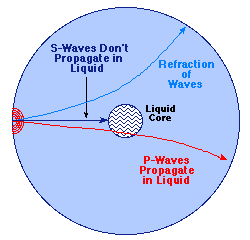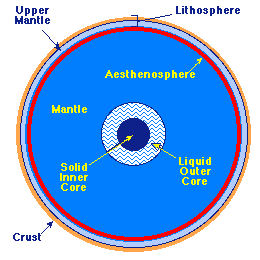The Interior of
the Earth
 The study of the Earth's surface and interior is the domain of
geology.
We know little directly about the
interior of the Earth.
Most of our
information in that regard has come from
seismic waves,
which are vibrations in
the body of the Earth.
The study of the Earth's surface and interior is the domain of
geology.
We know little directly about the
interior of the Earth.
Most of our
information in that regard has come from
seismic waves,
which are vibrations in
the body of the Earth.
Seismic Waves
There are two general categories of
seismic waves.
- P-waves, which are longitudinal pressure waves and can propagate in both
solids and liquids.
- S-waves, which are transverse waves that can propagate in solids but not in
liquids
Here is an
illustration of the difference between P-waves and S-waves.
These seismic waves, which are generated naturally by
earthquakes, by
volcanoes, and
impacts,
and may be produced
artificially by explosions and mechanical devices, tell us about
the interior in several general ways. The figure on the right illustrates
for a planet with varying interior density and a liquid core.
 First, seismic waves have their direction of motion changed
(refracted) by variations in the interior density. Thus, by studying
the way such waves propagate in the Earth we can learn something about density
variations. Second, the fact that P-waves propagate in liquids but S-waves do
not allows us to determine if portions of the interior are liquid.
First, seismic waves have their direction of motion changed
(refracted) by variations in the interior density. Thus, by studying
the way such waves propagate in the Earth we can learn something about density
variations. Second, the fact that P-waves propagate in liquids but S-waves do
not allows us to determine if portions of the interior are liquid.
Structure of the Interior
Accumulated and detailed seismic studies, coupled with theoretical speculation,
suggests the interior structure shown schematically on the left
(the figure is not to scale). The Earth is believed to
have a solid inner core,
made mostly of iron and nickel. This is surrounded by a
liquid outer core,
also mostly iron and nickel. The diameter of the core is estimated to be 7000
km, compared with a 12,700 km diameter for the entire planet.
The crust is only a few tens
of kilometers thick. The region between the core and the crust is called the
mantle. The upper part of the mantle and the crust together are called the
lithosphere. Sitting just below the lithosphere is a region of
plastic consistency called the aesthenosphere. We shall have more to
say about the lithosphere and aesthenosphere shortly.
 The study of the Earth's surface and interior is the domain of
geology.
We know little directly about the
interior of the Earth.
Most of our
information in that regard has come from
seismic waves,
which are vibrations in
the body of the Earth.
The study of the Earth's surface and interior is the domain of
geology.
We know little directly about the
interior of the Earth.
Most of our
information in that regard has come from
seismic waves,
which are vibrations in
the body of the Earth.
 The study of the Earth's surface and interior is the domain of
geology.
We know little directly about the
interior of the Earth.
Most of our
information in that regard has come from
seismic waves,
which are vibrations in
the body of the Earth.
The study of the Earth's surface and interior is the domain of
geology.
We know little directly about the
interior of the Earth.
Most of our
information in that regard has come from
seismic waves,
which are vibrations in
the body of the Earth.
 First, seismic waves have their direction of motion changed
(refracted) by variations in the interior density. Thus, by studying
the way such waves propagate in the Earth we can learn something about density
variations. Second, the fact that P-waves propagate in liquids but S-waves do
not allows us to determine if portions of the interior are liquid.
First, seismic waves have their direction of motion changed
(refracted) by variations in the interior density. Thus, by studying
the way such waves propagate in the Earth we can learn something about density
variations. Second, the fact that P-waves propagate in liquids but S-waves do
not allows us to determine if portions of the interior are liquid.